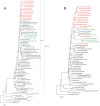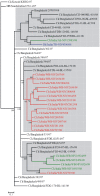Characterization of the influenza A H5N1 viruses of the 2008-09 outbreaks in India reveals a third introduction and possible endemicity
- PMID: 19924254
- PMCID: PMC2775943
- DOI: 10.1371/journal.pone.0007846
Characterization of the influenza A H5N1 viruses of the 2008-09 outbreaks in India reveals a third introduction and possible endemicity
Abstract
Widespread infection of highly pathogenic avian influenza A H5N1 was reported from backyard and commercial poultry in West Bengal (WB), an eastern state of India in early 2008. Infection gradually spread to Tripura, Assam and Sikkim, the northeastern states, with 70 outbreaks reported between January 2008 and May 2009. Whole genome sequence analysis of three isolates from WB, one isolate from Tripura along with the analysis of hemagglutinin (HA) and neuraminidase (NA) genes of 17 other isolates was performed during this study. In the HA gene phylogenetic tree, all the 2008-09 Indian isolates belonged to EMA3 sublineage of clade 2.2. The closest phylogenetic relationship was found to be with the 2007-09 isolates from Bangladesh and not with the earlier 2006 and 2007 Indian isolates implying a third introduction into the country. The receptor-binding pocket of HA1 of two isolates from WB showed S221P mutation, one of the markers predicted to be associated with human receptor specificity. Two substitutions E119A (2 isolates of WB) and N294S (2 other isolates of WB) known to confer resistance to NA inhibitors were observed in the active site of neuraminidase. Several additional mutations were observed within the 2008-09 Indian isolates indicating genetic diversification. Overall, the study is indicative of a possible endemicity in the eastern and northeastern parts of the country, demanding active surveillance specifically in view of the critical mutations that have been observed in the influenza A H5N1 viruses.
Conflict of interest statement
Figures



References
-
- World Health Organization. Cumulative Number of Confirmed Human Cases of Avian Influenza A/(H5N1) Reported to WHO. Available: http://www.who.int/csr/disease/avian_influenza/country/cases_table_2009_.... Accessed 2009 October 16.
-
- Ducatez MF, Olinger CM, Owoade AA, Tarnagda Z, Tahita MC, et al. Molecular and antigenic evolution and geographical spread of H5N1 highly pathogenic avian influenza viruses in western Africa. J Gen Virol. 2007;88:2297–306. - PubMed
-
- Starick E, Beer M, Hoffmann B, Staubach C, Werner O, et al. Phylogenetic analyses of highly pathogenic avian influenza virus isolates from Germany in 2006 and 2007 suggest at least three separate introductions of H5N1 virus. Vet Microbiol. 2008;128:243–252. - PubMed
Publication types
MeSH terms
Substances
LinkOut - more resources
Full Text Sources
Medical
Research Materials

